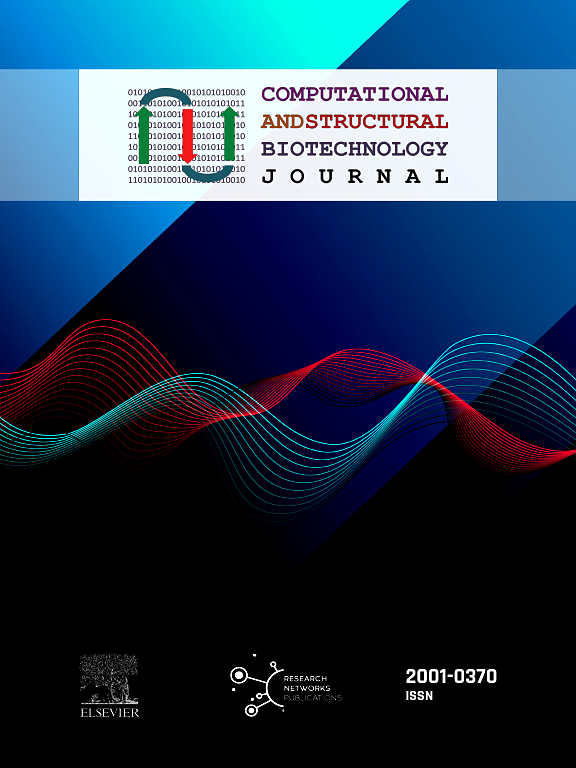Machine and deep learning to predict viral fusion peptides
IF 4.4
2区 生物学
Q2 BIOCHEMISTRY & MOLECULAR BIOLOGY
Computational and structural biotechnology journal
Pub Date : 2025-01-01
DOI:10.1016/j.csbj.2025.02.011
引用次数: 0
Abstract
Viral fusion proteins, located on the surface of enveloped viruses like SARS-CoV-2, Influenza, and HIV, play a vital role in fusing the virus envelope with the host cell membrane. Fusion peptides, conserved segments within these proteins, are crucial for the fusion process and are potential targets for therapy. Experimental identification of fusion peptides is time-consuming and costly, which creates the need for bioinformatics tools that can predict the segment within the fusion protein sequence that corresponds to the FP. Although homology-based methods have been used towards this end, they fail to identify fusion peptides lacking overall sequence similarity to known counterparts. Therefore, alternative methods are needed to discover new putative fusion peptides, namely those based on machine learning. In this study, we explore various ML-based approaches to identify fusion peptides within a fusion protein sequence. We employ token classification methods and sliding window approaches coupled with machine and deep learning models. We evaluate different protein sequence representations, including one-hot encoding, physicochemical features, as well as representations from Natural Language Processing, such as word embeddings and transformers. Through the examination of over 50 combinations of models and features, we achieve promising results, particularly with models based on a state-of-the-art transformer for amino acid token classification. Furthermore, we utilize the best models to predict hypothetical fusion peptides for SARS-CoV-2, and critically analyse annotated peptides from existing research. Overall, our models effectively predict the location of fusion peptides, even in viruses for which limited experimental data is available.
机器和深度学习预测病毒融合肽
病毒融合蛋白位于SARS-CoV-2、流感和HIV等包膜病毒的表面,在病毒包膜与宿主细胞膜融合方面发挥着至关重要的作用。融合肽,这些蛋白质中的保守片段,对融合过程至关重要,是治疗的潜在靶点。融合肽的实验鉴定既耗时又昂贵,这就需要生物信息学工具来预测融合蛋白序列中与FP相对应的片段。尽管基于同源性的方法已被用于此目的,但它们无法识别与已知对应物缺乏总体序列相似性的融合肽。因此,需要其他方法来发现新的推定融合肽,即基于机器学习的方法。在这项研究中,我们探索了各种基于ml的方法来识别融合蛋白序列中的融合肽。我们采用令牌分类方法和滑动窗口方法,结合机器和深度学习模型。我们评估了不同的蛋白质序列表示,包括one-hot编码,物理化学特征,以及来自自然语言处理的表示,如词嵌入和转换。通过对50多个模型和特征组合的检查,我们取得了有希望的结果,特别是基于最先进的氨基酸标记分类转换器的模型。此外,我们利用最佳模型预测SARS-CoV-2的假设融合肽,并对现有研究中的注释肽进行批判性分析。总的来说,我们的模型有效地预测融合肽的位置,即使在实验数据有限的病毒中也是如此。
本文章由计算机程序翻译,如有差异,请以英文原文为准。
求助全文
约1分钟内获得全文
求助全文
来源期刊

Computational and structural biotechnology journal
Biochemistry, Genetics and Molecular Biology-Biophysics
CiteScore
9.30
自引率
3.30%
发文量
540
审稿时长
6 weeks
期刊介绍:
Computational and Structural Biotechnology Journal (CSBJ) is an online gold open access journal publishing research articles and reviews after full peer review. All articles are published, without barriers to access, immediately upon acceptance. The journal places a strong emphasis on functional and mechanistic understanding of how molecular components in a biological process work together through the application of computational methods. Structural data may provide such insights, but they are not a pre-requisite for publication in the journal. Specific areas of interest include, but are not limited to:
Structure and function of proteins, nucleic acids and other macromolecules
Structure and function of multi-component complexes
Protein folding, processing and degradation
Enzymology
Computational and structural studies of plant systems
Microbial Informatics
Genomics
Proteomics
Metabolomics
Algorithms and Hypothesis in Bioinformatics
Mathematical and Theoretical Biology
Computational Chemistry and Drug Discovery
Microscopy and Molecular Imaging
Nanotechnology
Systems and Synthetic Biology
 求助内容:
求助内容: 应助结果提醒方式:
应助结果提醒方式:


